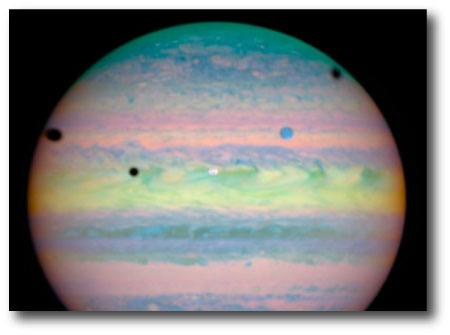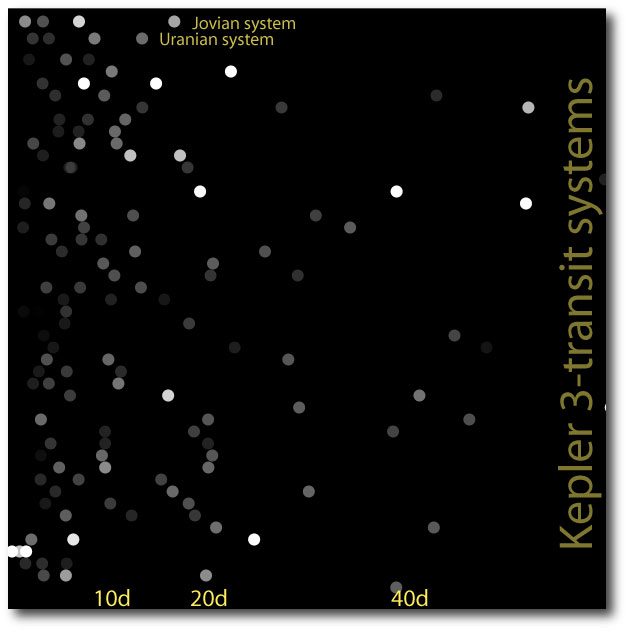Image Source.
If one looks at planetary systems from the “modern” point of view provided by the HARPS survey and the results from Kepler’s recent data release, our own solar system looks pretty strange. In the Sun’s case, the frequently planetiferous orbital zones inside of P=50 days are completely, mysteriously barren. The orbital region inside P<3000 days is also almost entirely bereft, with just a few iron-silicate dregs totaling less than two Earth masses. Out in the boondocks, however, the Sun’s harbors a giant planet that managed to accumulate lots of gas, yet paradoxically didn’t manage to migrate a really significant distance.
It will take more time to determine whether the solar system is really all that weird, but with each passing month’s accumulation of fresh exoplanets, our eight-planet set-up manages to seem slightly less ordinary. Jupiter, for example, induces a 12 m/s velocity half-amplitude, and the high-precision radial velocity surveys have been operating for long enough so that if true-Jupiter analogs were the rule, then we’d perhaps be hearing of more of them being detected.
The Kepler multi-transiting candidates correspond to systems that are completely alien when compared to MVEMJSUN, but they are much more familiar when compared to the regular giant planet satellites — the moon systems of Jupiter, Saturn and Uranus. In each of these cases (and despite a factor-of-twenty difference in mass between Jupiter and Uranus) the characteristic orbital period is of order a week, and the characteristic secondary-to-primary mass ratios are of order a few parts in 100,000. For example, Ariel, Umbriel, Titania and Oberon have mass ratios of 1.6e-5, 1.4e-5, 4.0e-5, and 3.5e-5 relative to Uranus, and their orbital periods are 2.52, 4.14, 8.71, and 13.46 days. In the Jovian system, the satellite/Jupiter ratios for Io, Europa, Ganymede and Callisto are 4.7e-5, 2.5e-5, 7.9e-5, and 5.8e-5, with corresponding orbital periods of 1.76, 3.55, 7.15, and 16.68 days.
In the plot below, I’ve taken the 45 three-transit systems from Kepler’s list, and plotted the orbital periods of their constituent planet candidates along the x-axis. The colors of the points are given a linear gray-scale, with black corresponding to a planet-to-star mass ratio of zero, and white corresponding to a planet-to-star mass ratio of 1.0e-4 or larger. I’ve converted radius to mass by assuming M=R^2 when mass and radius are expressed in Earth masses and Earth radii.
It’s interesting to speculate whether the commonality between the regular satellite systems, and the teeming population of Super-Earth/Sub-Neptune class systems might be more than just a coincidence…



Of course our solar system is weird. It’s the only place we know of where intelligent beings are contemplating the existence of Earth-like planets.
In the next three years (or more) we should know a lot more about what we are talking about.
Pingback: Dal blog di systemic: quanto è atipico il nostro Sistema Solare? « Rainbowman56's Blog
The other strange thing about our solar system is how late the inner planets formed. We know from radioisotopes that Earth and Mars took 30-50 million years to form (possibly longer), and we know from geochemistry that this formation occurred in a low hydrogen environment, indicating that the gas had dissipated by then. But the existance of close-in sub-neptunes means that planets formed close to their stars while there was still gas to attract into envelopes, implying much younger inner planets.
Question is whether Jupiter didn’t migrate much, or if it did migrate but ended up near where it started. I’ve heard a few suggestions that Jupiter migrating inwards then out again is quite useful if you want Mars to end up with a low mass. IIRC studies of planet migration show Jupiter-Saturn pairs migrate outwards, maybe you need this kind of thing to stop the inner system getting too many volatiles. 47 UMa could be an interesting hunting ground.
Any predictions for Alpha Centauri in light of all this? There shouldn’t have been much of an ice-rich outer disc around either of A or B…